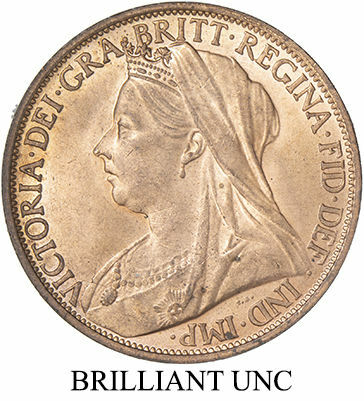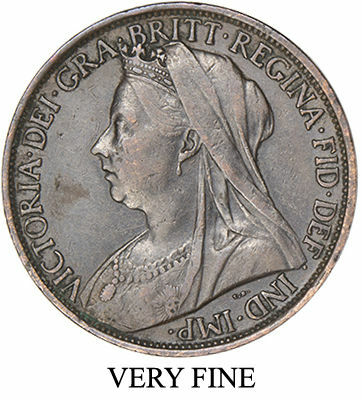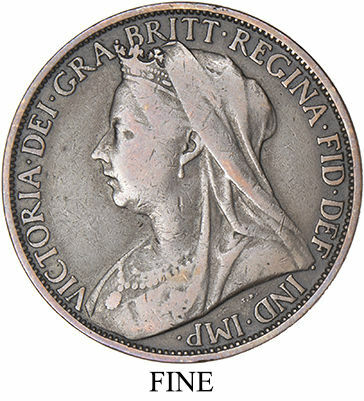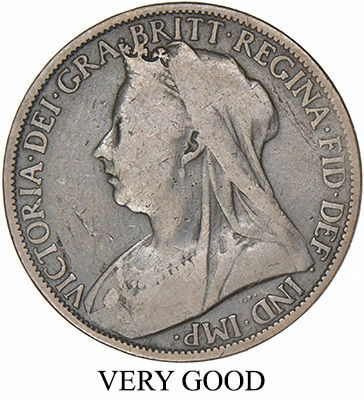Coin Grading – A Basic Guide for Coin Grading in the UK
Coin Grading is the biggest area of contention in coins. Because the price of a coin is in a great part dependent on its condition, this can be open to many interpretations. Even leaving aside those dealers who deliberately over grade their coins and then advertise them ‘cheaply’, to appear that they are giving you a bargain. The best advice we can give you is, if it appears too cheap, there is a reason for it...
To learn to grade properly takes years of experience and actually handling thousands of coins. You have to know how a coin was made: a hammered coin is vastly different from a milled coin. Learning about the dies, how they were engraved, how long they lasted and what they looked like as they started to wear, is also necessary. You need to know what an Uncirculated example looks like before you can determine if a particular coin is worn, or if it was just struck that way.
And what does Uncirculated mean on coins?
Usually, there is no wear on the highest points but the design may not be fully struck up due to the engraving of the die or its wear. Copper and bronze may or may not have lustre, depending on where and how they were stored.
That’s why it is important to learn how to distinguish original lustre from something which may have been done in order to try and artificially replace that lustre.
Grading correctly is even harder than it sounds. Today a coin's grade is generally determined by five factors, the strike, wear or condition, lustre, colour, and attractiveness. Although attractiveness is a very subjective factor.
In the old days, a coin was either new or it was used. A used coin could be Fine or it could be Extremely Fine, it was just not new. Today, because of the difference in price between an almost new coin and a new coin, you have to be more careful.

Coin Grading UK
Going from the lowest grade to the highest the coin grading system in the UK is as follows:
Poor (P) – extremely worn and most of the details will be missing but you will still be able to identify the coin as to type.
Fair (FR) – A grade where the coin has seen much wear and it is only just discernible what the coin is. Collectors usually stay away from this grade unless the coin or note is especially rare or expensive.
Good (G) – A grade which denotes a considerable amount of wear. The coin is discernible but the lettering may not be clearly visible.
Very Good (VG) – A grade where the coin has experienced a lot of wear and where the details are still discernible but worn.
Fine (F) – A grade when the coin or note has seen considerable wear but is still very collectable. Many collectors like a used coin because they feel that it has actually been somewhere. Collectors on a budget also like this grade.
Very Fine (VF) – A grade of coin where there has been obvious but relatively restricted wear on the highest portions of the coin.
Extremely Fine (EF) – A grade where there is little actual wear except on the high points. On copper and bronze, original lustre might well still be in evidence. A most appealing and attractive grade, much undervalued by the marketplace in its seeking of the ultimate perfection.
About Uncirculated (AU) – A grade which is designated as About Uncirculated.
Uncirculated (Unc) – A grade which indicates that a coin has never been released into circulation. Although a coin may be less than perfect when struck, with scratches and nicks, that does not mean that it is not Uncirculated. Over the years a coin may tone or a copper coin may change from bright to dark, again this does not mean that it is not Uncirculated. The term literally means a coin which has not seen circulation
Brilliant Uncirculated (Brilliant Unc) – On copper and bronze coins it means bright and shiny just as they came from the mint. On silver coins, it means with little or no toning, perhaps the middle coins from a roll where the outer coins have toned.
Choice Uncirculated (Choice Unc) – A coin is Uncirculated if it has never been in circulation and is without wear. But due to the vagaries of how coins are struck, how the dies were made and how the coins were treated after striking, there are different grades of Uncirculated. Choice Uncirculated is better than a normal Uncirculated coin with far fewer bag marks and is well struck with full and uninterrupted lustre.
Gem Uncirculated (Gem Unc) – A grade of a coin struck for circulation. We consider this to be the highest grade that a coin can achieve. There must be full and outstanding lustre, an exceptional strike, no nicks and only the smallest bag marks discernible under a strong glass. This quality is harder to achieve in larger sized coins than in smaller sized ones. Fewer than 2% of all Uncirculated coins can be called Gem.
Mint State (MS) – As a grading term, it refers to the highest grading a coin can have. It is also referred to as FDC.
Fleur de Coin (FDC) – A French term which translates as `flower of the die' and means Uncirculated. This term was used far more when coins were either mint or used. Today we use the term to represent a full mint state coin in impeccable condition (perfect Uncirculated of at least choice quality). Used far more on the Continent than in Great Britain today.
Proof – In this country proof is a method of striking and not a condition. A proof coin is struck most carefully with polished dies and a polished flan. It will be struck more than once to get the high relief to show all the fine details. Sometimes you will get a lead piece with half of a coin, this is done to proof the die before striking.
Be careful about grading and until you learn how to grade yourself, deal with someone you can trust.
Coin Grading in the US and in other countries
The grading list in other countries works differently, but these days in the international market place people only use the UK or US system. The main difference between coin grading the UK and in the US, is that in the United States, they use a numerical grading system (Sheldon grading scale), instead of using grading terms e.g. Very Good, Fine, Uncirculated.
In this system there are no less than 10 different grades of Uncirculated. They grade an Uncirculated coin on a numerical basis, anywhere from 60 out 70 to the ultimate which is 70 out of 70. The price difference between 64/70 and 65/70 can be anything up to ten times the price.
We at Britain's Coin Shop, believe there are only three grades of Uncirculated:
- Uncirculated – a coin that has not been in general circulation, but may have toned or have light bag marks from the production process. Some Uncirculated bronze coins will have a lot of original mint lustre these are known as Brilliant Uncirculated.
- Choice Uncirculated – this is an uncirculated coin which may retain a lot of the original mint brilliance or could have acquired a tone.
- Gem Uncirculated – these only represent the top 1% or 2% of uncirculated coins, the fields will be flawless and the coin may well retain most of the original mint brilliance.
Coin Grading Examples
As we mentioned before some dealers are a little too generous with how they grade coins, over grading them and then advertising them ‘cheaply’. We are one of the most reputable coin dealers in the UK, and our reputation in the marketplace was partly built by the way we grade coins.
Below are a few examples of how we, at Coincraft – Britain’s Coin Shop, grade Victorian coins in silver (Young Head) and bronze (Old Head):
Victorian Young Head Silver Shilling
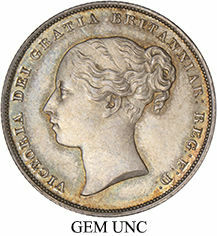
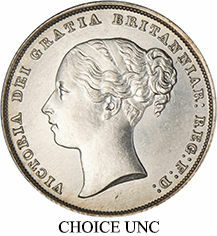
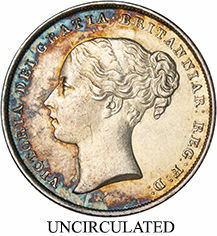



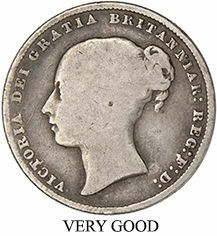
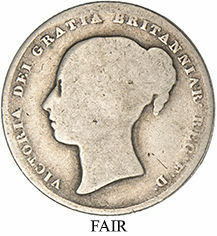
Victorian Old Head Bronze Penny
